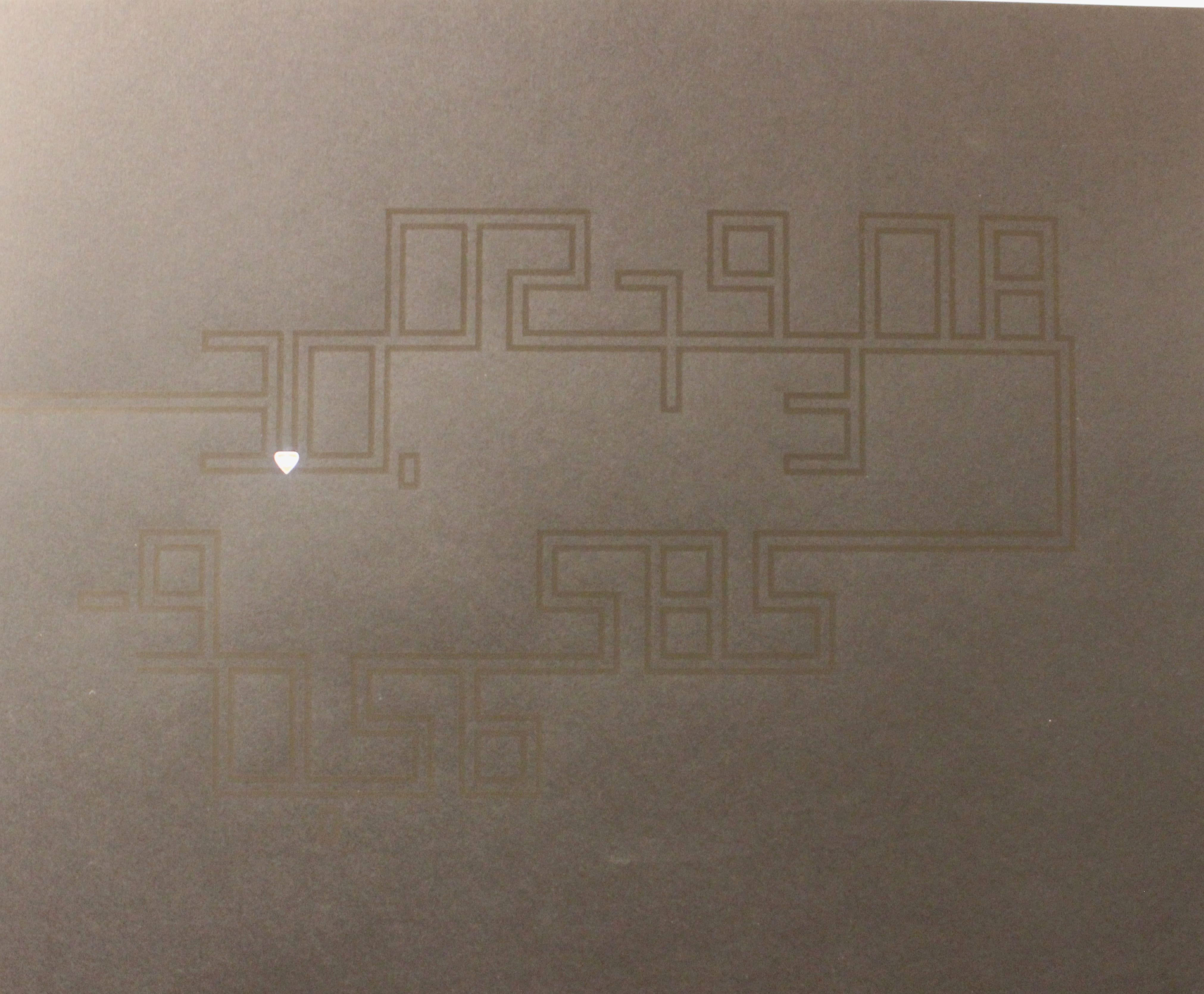This curatorial discussion on the Hawn Gallery exhibition, Clear, Deep, Dark, focuses on its artist, Julie Morel. Every two weeks during the exhibition’s run, Curatorial Fellow, Emily Rueggeberg, will post a new article highlighting one or more of Morel’s pieces from the exhibition to provide insight into the artist’s creative and theoretical processes.

(2 copies)
The IP and GPS series in this exhibition are made with LED lights and conductive ink silk printed on matte black paper. Conductive ink is typically reserved for mechanical purposes; however, Morel saw its potential as a drawing tool. Behind each piece are electrical circuits connected to the ink that guide electricity to the LEDS, in turn lighting the work. While Morel displays her IP and GPS series in the Hawn Gallery, she simultaneously hides corresponding pieces online and in private spaces.
In IP#1, IP#2, and IP#3, the silk printed letters and numbers are in fact computer IP addresses where Morel has stored artwork. GPS#1, GPS#2, and GPS#3 are GPS coordinates also referring to locations of Morel’s work. The pieces alluded to in the GPS series are in fact physical objects placed in private or remote spaces; a city apartment, an island in the Pacific Ocean, and a country home.

When one enters the GPS coordinates printed on the works, a satellite image of the location appears on their computer screen. When the satellite image is laid over the print, the small pinpoint of light indicates the object’s location. The objects’ locations are simultaneously discoverable and unobtainable, just out of the viewer’s reach.

Upon initial inspection, Morel’s conductive ink pieces appear to be more aligned with drawing or conceptual art than new media. The pieces take on new identities when it is revealed they are simultaneously hiding and revealing other pieces on hard drives or inaccessible locations. New media art certainly incorporates the aforementioned mediums, particularly conceptual art in its value of the creative/theoretical process over a finished product when creating art. Another crucial component of new media art is its utilization of technology including, but not limited to, computer animation, software programing, coding, and video. It’s important to make the distinction between new media art and art that uses technology. New media art isn’t just digital art; it’s art that experiments with the newest technologies and exploits them to reveal social themes.
New media art is a direct result of current cultural events, mass media, and data sharing. New media is intended to be easily disseminated amongst the public and, in many cases, challenge the common narrative being fed to viewers. There is no definitive definition for new media art as it is amorphous and ever-changing, transforming with new technological advances and society’s increasingly digitally driven lives. In New Media Art, the authors, Mark Tribe and Reena Jana, attempt to pin down new media in its current state circa 2006. They define new media art as works “…that make use of emerging media technologies and are concerned with the cultural, political, and aesthetic possibilities of these tools.”[1]
Of course much has changed in the artistic and technological fields within the 12 years proceeding Tribe and Jana’s writing. The underpinning concepts of much new media art has not. It continues to explore new ways of merging technology and art as well as challenging existing hierarchical structures in cultural institutions. New media art also serves an important function of removing classical art historical taxonomies such as Impressionist, Modern, Abstract, or others, and it challenges curators to reconsider their display and categorization of artwork as well as what constitutes ‘fine art.’
CLEAR, DEEP, DARK is on view through March 11, 2018. The gallery is open daily, M-TH 8AM-9PM, F 8AM-6PM, Sat 12PM-5PM, Sun 2PM-9PM and free to the public.
For more information, please call 214-768-3813 or visit www.smu.edu/cul/hamon.
Follow us on Instagram @hawngallery
Curated by Emily Rueggeberg, Curatorial Fellow for the Hawn Gallery
[1] Tribe, Mark., and Reena. Jana. New Media Art. Basic Art Series. Köln ; London: Taschen, 2006. P.6.
Featured image: Installation view of CLEAR, DEEP, DARK (objects from right to left): IP#1 IP#2, Clear, Deep, Dark (Conductive tape on black paper, triangular LEDs, electric circuit.
Dimensions: 30” x 20”.) Constellations (series of 5) (2017)
(Silver ink on black paper. Dimensions: 30” x 20”)
Images: Courtesy of installation shots by Emily Rueggeberg.
